Advances in Internet of Things
Vol.2 No.3(2012), Article ID:21353,11 pages DOI:10.4236/ait.2012.23008
The Influence of Memetic Primers in Online Comments in Video Game Blogs
State University of New York Institute of Technology, Utica, USA
Email: Ibrahim.yucel@gmail.com
Received April 7, 2012; revised May 12, 2012; accepted May 26, 2012
Keywords: Computer-Mediated Communication; Social Networking Site Design and Use; Virtual Worlds/Avatars/Proxies; Community Analysis and Support; Virtual or Physical; Entertainment/Games
ABSTRACT
Through investigating a particular blog, several factors were found which have significant influence on reader actions. This study uses the term “memetic primers” for those styles that most often cause readers to take notice of a particular comment, remember information included in it, and take action. The memetic primers were derived in a discourse analysis. The study discovered the memetic primers using logic-of-inquire approach to the online comments. While evidence indicated that the usefulness of some primers was low, it emerged those negatively written comments where the most common impact on a comment’s volume.
1. Introduction
In today’s digitally driven and fast paced media landscape, blogs have emerged as a powerful and growing media outlet. This new media is at once a noun and verb, both as the site and the uploading of new information. Blogs evolved from Web 2.0 technologies which allow for content creation without the need of hypertext scripting or programming ability. Instead, through simple interfaces on the website themselves, these sites can quickly grow with entire communities contributing to their content. With further development, most blogs incorporate the best the Web 2.0 has to offer-video feeds from YouTube and profile management for all their devoted readers. Such websites are connecting individuals with similar interests into communities. Many blogs often focus on one or two topics, tightening community bonds and increasing member investment by providing insights from both experts and amateurs in a shared space.
These messages that are more prevalent and easy to read within online communities are referred to in this study as “shouts”. The idea of shouts grew from a PricewaterhouseCoopers white paper, which was aimed at gauging a client’s reputation on the Internet, as well as from various studies analyzing popular opinion as expressed on blogs [1-4]. The white paper suggested that whispers of customer interaction gradually grew in volume into shouts as they proliferated across blogs and other forms of media [4]. This concept can be applied on a smaller scale. The mixture of popular opinion, memes, and shouts combine to create what this study will refer to as “memetic primers”. When a particular comment acts as a memetic primer, it gains attention and causes those reading the comment to remember the conversation.
While examples of powerful comments are be found readily on the Internet, it’s beyond the scope of this study to consider all commented pages and blogs, since each community has a commenting style of its own with its own nuances. Therefore, as is explained in detail below, the focus of the study will be special-interest blogs, specifically blogs that cover news of the video game industry. This focus on blogs with community identities allows us to gain more insight into their behavior, through methods established in socio-technical fields. Special-topic blogs show some evidence to support the view that their members, due to shared interests, are inclined to “bandwagoning” heuristics [5,6]. “Bandwagoning” is a component of the MAIN Model, a mental model of media consumption [7]. This heuristic governs a trust decision on part of the reader, making the reader more likely to agree with the major opinion in the community. This phenomenon, in addition to other heuristics within the MAIN Model, may give insight into the “volume” or “loudness” of a given comment.
Memetic primers also are potentially useful for providing new insights into both analyzing web discussions and forecasting trends in web communities. Interest in the examining discourse that happens in online spaces is increasing in both academia and industry [1-3,8]. This analysis provides a way to gauge the opinions of large, interested collectives of experts, in order to predict outcomes in various fields. Adamic and Glance’s study of the predictions of bloggers during the 2004 presidential campaign is an important example of this technique [1]. Many predicted a very insular and divided election, and the study of the blogging community confirmed that crossposting between liberal and conservative blogs was very uncommon, indicating that both groups were “mini echo chambers”. In essence, people tended to comment on and link to evidence on sites they agreed with [1].
Formation of a consensus within a community is only one way a shout can increase in volume. While consensus in online communities does develop over time, arguments and differences in opinion can also call attention to comments and be a predictor of shouts. A community without dissenters is unlikely. A single story may draw hundreds of comments, and that story may then be copied in another community drawing hundreds of that community’s own comments. Each one of these comments may contain subtleties that make any comment difficult to classify as positive or negative, as opposed to sarcastic. This nesting of meaning and context creates huge problems for those examining trends in communities in hope of predicting consensus. However, if in fact most readers notice only the comments with the most volume, it is possible that a smaller set of comments could be used to gain insight into a community.
This paper first reviews the literature regarding blogs and memes, and the frameworks used to create the term memetic primers. Then, possible primers are identified on the video game blog “Kotaku”. An analysis and implication for the consideration of memetic primers in online community design follows.
2. Literature Review
2.1. Blogs
There are many of definitions of “blog” available that include varying amounts of detail on the word’s first use and coinage, but Blood’s history of the origin of blogs is most often cited. She provides a large number of sources and studies both the creation of the term “blog” and the authors who created those definitions. Blood identifies the first use of the term “weblog” by Jorn Barger, a frequent web surfer who began to log websites he visited and found interesting by publishing the list on his own website [9]. The term “blog” evolved from this first site as others began to create similar logs on their own sites. One of these was Jesse James Garrett’s site that started to compile a list of similar sites. Garrett’s list eventually came into the hands of Cameron Barrett, who published it on his own site, Camworld. Garrett’s list of twentythree “only weblog” pages soon grew until much of the web was following the style of updates which began with these “weblogs”. The term “weblog” was shortened to “blog” and the activity of updating the page began to be referred to as “blogging” [9-11].
As the nascent blog community grew, readers began to add their own blogs to Garrett’s list and to expand the definition of “blog”. Blood mentions starting her own blog within this community in April of 1999. As the blogger community grew, it became increasingly difficult to read through the output of the entire community regularly. The founders of this community began to limit their listings of blogs to those they themselves frequented on a daily basis. At this point, Brigitte Eaton’s Eatonweb Portal attempted to provide a directory of all blogs, the only criterion for listing being inclusion of a series of dated posts [12]. Eatonweb Portal grew in popularity as tools became available for automatically creating blog spaces. Blood cites Pitas.com as the first of these tools. Soon the web was flooded with other tools such as Blogger and Groksoup. Later web community pages such as Myspace, Livejournal, and Facebook made creating personal spaces with dated entries almost universal web culture. Soon sites like Reddit, Slashdot, and Fark brought their own communities into the picture, linking to blogs and news stories on the web, and creating a form of metacommunity of those who read blogs and in turn became part of the definition themselves [10,11,13,14].
Blog Classification
The term “blog” is used to cover a variety of styles. The primary function of a blog helps define it further by subtype. Blogs, which started out mostly as communities recording day-to-day events, have evolved into many different types of blog subgenres [11]. These subtypes can in turn be divided according to the number of authors writing on a particular blog, as seen in Table 1.
Blogs with a single author are often personal in nature, serving as diaries visible to the web [13]. A number of services are offered on the web to help authors automatically create such personal blogs. These services include Blogger, Livejournal, Myspace, Twitter, and Facebook. Most personal blog services act as community boards, encouraging interactions between members with similar interests. Individual blogs, while mostly of a personal nature, can vary in their content. For example, while one member of Livejournal may use his or her blog to keep in
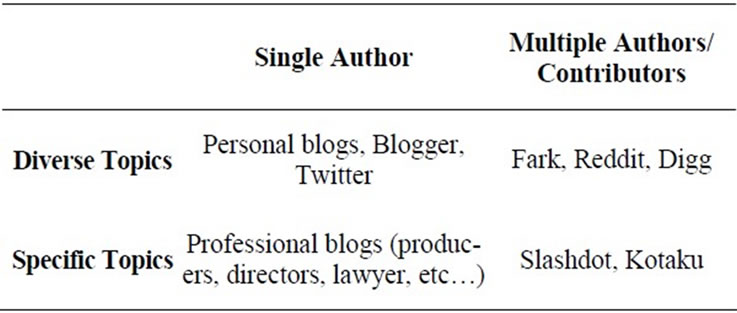
Table 1. Blog classification.
touch with family and friends, another member may use a blog in a professional capacity to discuss a new project and communicate with a professional readership [14,15].
Blogs with multiple contributors, such as Slashdot, usually are either formed by contributions from a community or have a number of editors, as in the case of Kotaku. These contributors act as reporters for the blog, finding links to suggest to their readership. Many of these sites focus on a specific topic [11]. Such topics are usually associated with already established communities. Science and technology news is the focus of Slashdot, while Kotaku has a more specific focus on video games and Japanese culture. More general blogging communities have fewer restrictions on what posts are worthy. Sites like Fark, Reddit, and Digg receive submissions from their readers and post them for other readers to comment on. These communities discuss current news and provide commenters with tools such as image and HTML links to help enhance discussions [11]. Understanding all of these blog communities and mining their discussions is an area researched by authors in socio-technical fields.
Blogs with multiple authors and specific topic classifications were chosen as the most useful for this study, since they include the largest number of users, all centered on one particular subject. While individual blogs (such as those on Blogger) may also have communities and comments, comments on these sites are usually addressed to the blog’s author rather than to a community. On large, multi-author blogs without a central focus, the great number of posts and diversity of topics encourages commenters to simply make statements rather than to discuss topics. On such sites, popular topics also tend to be on polarizing political or social issues. In these cases, trolling (posting comments aimed at inciting anger) and “echo chamber” responses are very common [1].
2.2. Memes
Use of the term “meme” is expanding and slowly changing due to its use in describing Internet culture, but the term’s roots are in the book The Selfish Gene by Richard Dawkins [16]. The book describes the evolutionary process as competition between genes that are not working toward the “good of the whole species”, but rather acting “selfishly” to preserve themselves [17]. Furthermore, genes are one of many “replicators” which transfer information down generations via “vehicles” that protect data [17]. From this comes the use of “meme” to mean a unit of cultural transmission, or as Blackmore puts it, a unit of imitation from the Greek “mimeme” for something imitated [16]. Dawkin’s examples of memes include a description of how a scientific idea jumps from the mind of one scientist to another, replicating itself until it is eventually accepted by the entire scientific community. Brodie takes this concept further, asserting that memes form the basis of the “paradigm shift” first proposed by Kuhn during the transition from Newtonian physics to Einstein’s new theories on relativity [18]. Following this train of thought further, Brodie proposes that not only do memes replicate, but they do so aggressively like a virus [18]. Brodie’s “meme” is comes closest to the terms popular usage on the Internet.
Memetic primers, as described in this paper, build from the original, academic definition of memes. The definition of memetic primers falls into a very specific context and implementation much in the way “Internet memes” fit a narrow subset of the broader academic use of the term meme [18]. Memetic primers are guidelines that prepare the user to treat the concept presented as a meme, rendering the concept memorable and increasing the volume of the comment. For example, inflammatory comments may cause a number of effects that make them stick out in the reader’s memory and incites them to reply, increasing the visibility of the comment for future readers. Shouts, very loud comments, are not always memes, but most memes receive shout-like levels of attention and could possibly be used to attract more attention to a comment on a blog. Another distinction between a meme and a shout, as described in this study, is that a meme has won an established following while a shout may still be growing in outreach or “volume”. Various websites, such as Reddit, Fark, and Slashdot act as growth media, spreading and amending a particular meme until it is “heard” by all in the community [19]. As Ohanian points out in his TED talk, the goals of the community are not very predicable, so it is hard to say what the members will elevate to meme status and what will remain whispers on a website [19]. In his example, whale hunting by Japan was not a major concern of the Reddit community until the goofy idea of naming the mascot of Greenpeace’s anti-whaling initiative, “Mr. Splashy Pants”, motivated the community to take action [19].
Definition of Memetic Priming and Memetic Primers
Memetic priming is an element of communication that snares the reader’s attention and prods them to repeat and spread the meme. Memetic primers are the guidelines that, if they exist, can be keys to understanding how to attract attention and more readily spread information virally on the Internet. Depending on the context of the message and the audience, it is possible that these primers are very complex. Cultural differences may be an even larger hurdle, as one not familiar with the culture of the community will possibly overlook its memetic primers. I theorize that memetic primers would not be transferable between cultures for the most part. A meme based in humor in one culture could fall flat in a culture that did not find it funny.
An example highlights what memetic primers are and how they differ between communities. Let us take two Internet communities, Reddit and Fark, for example. Both of these communities have sections in which politics are discussed. If one were to use a negative memetic primer— say, using slanderous untrue remarks about a candidate—the reaction and eventual volume of the comment would differ between the communities due to differences in the social norms and moderation styles. If the candidate was particularly liked in the Reddit community, the community would use “down votes” (a negative form of moderation) to move the comment down and further from view. In Fark, comments are always presented in the chronological order in which they were posted, so users tend to repeat comments using italics to form a reply to something they either agree or disagree with. Regardless of the situation, agreement or disagreement, within the Fark community the negative primer gains volume and attention.
The deeper our understanding of the effect of memetic primers on consumption of media, the more effectively we build defenses against those who would abuse them. For example, negative language should play a significant role in memetic priming. Much of our current understanding of media, as stated earlier in this chapter, shows the influence negative media has on people. This, in turn, has created an influx of negative media to broadcast and print news. In a market where audience size is paramount, any sensational hook will be used to grab attention. This abundance of negative information has caused significant damage to public understanding of the world. Recent studies at Georgia State University [20] show evidence that, even when corrected with hard facts, individuals’ tend to believe what they are first told, and that corrections may even further cement their faith in incorrect information. With a better understanding of how memes work to spread information, steps could be taken to lessen the impact of false information, exposing the abuse of memes.
2.3. Source
Source is a concept that is central to communication theory [21]. It is a concept that changes meaning with new technology. It is a mental understanding of the reader where they receive their information. Source requires careful study when applied to new forms of computer based communication, since a clear and concise definition is not available even in traditional media [21]. In Sundar and Nass’s article “Conceptualizing Sources in Online News” the authors found that online news creates new sources not found in other forms of media, (such as the computer itself and the website’s audience). This realization brings new insight into how all new media, including blogs, are conceptualized by their readers. New media holds a large number of sources not considered in more traditional forms of communication. Readers must manage these new sources to transform the article into knowledge that they can act upon. There are a number of models which can be used to as a framework to for the consumption of online media, one of which is the MAIN Model.
2.4. MAIN Model
The MAIN Model (Figure 1) provides a framework for analyzing how readers perceive information from new media, such as blogs, and makes judgments of the media’s credibility. This framework can be focused on credibility judgments about comments, which influence any actions the readers may take. This, in turn, affects the comment’s volume on the blog. Of particular interest is the second layer of the MAIN Model, in which heuristics are used by readers to make credibility judgments on online media. These heuristics are organized by the affordances that accommodate them. Utilizing a number of these heuristics, the reader makes credibility judgments, consciously or unconsciously. Although each of these levels is quite complex, it is possible to isolate a few of these heuristics and examine how they apply to a specific form of new media [7].
Within the MAIN Model one can see a heuristic that is central to the blog affordance of agency, the Bandwagon Effect. While blogs are a great place for those interested in certain topics to read up on the latest news, they are most frequented by those enthusiastic on the subject

Figure 1. The MAIN Model [6].
matter. Through comments, these users interact and in turn affect new readers, creating a consensus in the community via these heuristics. “The Bandwagon Effect of Collaborative Filtering Technology” is a study that looks at the use of the Bandwagon heuristic in purchasing items on sites like Amazon, where comments can sway buyers [6]. In that study, commenters are the primary source of information, however when looking at blogs one has two sources of information, the author and the commenters. This study looks at the interaction between the commenter source and the readers of these blogs. Memetic primers are the means in which a commenter may possible cue a reader to act, in the effort to create a meme.
Proposed Framework
The following figure (Figure 2) describes how this study poses the interaction between the blog and reader creates a shout.
Blogs have many affordances that may lead to a credibility judgment. These credibility judgments influence volume of the comment. The new framework focuses on this volume and how a memetic primer can initialize interest. The original flow does not model any decisions to take action, either in the form of replying to a comment or taking other forms of action on the comment. By allowing the reader to then take action, these actions may then increase the interest other have in the comment, thus increasing the comment’s volume. This loop continues until a comment becomes a shout or meme.
3. Method
An in-depth examination of online discourse provides a solid foundation for understanding possible memetic primers. This required the identification of a web community with a commenting system that encourages members to write popular comments. Since the term “discourse analysis” is very common and used interchangeably with many different forms of research, it requires a more detailed explanation. First, this study will not fall into the subcategory of “critical” discourse analysis as the study


Figure 2. The MAIN and proposed framework.
does not presume that any group has a position of power which perpetuates the condition over others in the case of these blogs. While blogs may address critical issues, the form of the research question does not address anything that would require a critical perspective [22]. This study will instead use a discourse analysis that examines the Logic-of-Inquiry approach of discourse analysis used often in education [23] while also having intercoder verification to protect against bias. The Logic-of-Inquiry discourse analysis takes a look at the conversation of students, taking apart the meaning in their discourse to discern the student’s intention and logical process [23]. I believe that with the application of this style of open coding discourse analysis I would better understand if the user was attempting to be sarcastic or trolling by identifying their thought process.
The first requirements of a Logic-of-Inquiry and intercoder verification entails there will be two coders performing the discourse analysis. The coders will read each comment, inductively creating the codes from the content of the discussion as opposed to using a preset deductive set of codes. Using such a preset coding scheme would hurt the investigative nature of this study phase and may hide unexpected elements in the comments. The codes made by each researcher are then compared to find inconsistencies that could occur from bias. While Logicof-Inquiry was originally intended for educational settings, Gee and Green state that discourse analysis “provided new insights into the complex and dynamic relationships among discourse, social practices, and learning” which indicated it would be suited for use in online social spaces [23]. The reason for this is the closeness of the theoretical underpinnings of Gee and Green’s approach that links language and community to knowledge. This method also discusses in detail the use of situated meanings, cultural models, and reflexivity needed in understanding knowledge generated from discourse. Many of the online discussions, in particular special interests discussions, are dense with cultural connotations and meaning. The Logic-of-Inquiry methodology has an understanding of community and situated meanings that match well to the online discussions found within web communities. Both coders of the data set were familiar with video game culture and current events so they could understand the context of each comment. Utilizing this method, the comments from a blog summary with the most replies or highest community score were coded to identify possible memetic primers. After coding had been completed, the power of possible memetic primers were identified by a quantitative analysis between the codes and responses and percentage of comments devoted to the comment. The two primary metrics to determine the “volume” or “loudness” of the comment were the number of replies the comment received and the percentage of all the comments on a topic that were replies to the comment. This thread percentage value indicates how capable a comment was in controlling the conversation and is referred to as loudness.
Codes
Two code sets were inducted from the comments by a pair of researchers. These sets where then compared to each other to determine intercoder reliability. Each set was analyzed independently to find any significant correlations of the codes to the metrics mentioned above. Loudness, once again, is the percentage of all comments in the post that were replies to the shout. For example, if the most popular comment in a thread has 35 replies, and the total number of comments to the subject is 100, then loudness of the comment would be 35/100 or 35%.
The following Table 2 lists the codes created from the analysis of comments by both coders. They are listed in order of possible significance (anecdotally, from codes that appeared in both sets and occurred most often). Those marked with an asterisk were found by both coders independently.
As one can see there is much overlap between the two code sets. Positive, Negative Tangential, Inflammatory, Question, Explanatory and Humor are all identified as elements in the comments that need illumination. This is in addition to other pairs of codes that share similar meaning like Exp for Expansion and Story codes. The


Table 2. Raw codes.
number of codes per comment however was different for each coder, as one coder tended to only attribute one or two codes per comment while the other coder was more detailed in the content of each shout.
4. Analysis
Qualitative codes from each set are listed in Table 3. They had their distribution analyzed to see if the number of occurrences would be sufficient for variance tests. A number of the codes did not have enough instances to be properly analyzed. These included List, Story, Null, Fact, Txt, Vowel, Critical, Community, Video, Informative, QA, Exp, and Cor.
4.1. Negative Comments
Negative comments were associated with a number of significant findings as seen in Figures 3 and 4. First, as shown on the chart of occurrences, they have a large num-
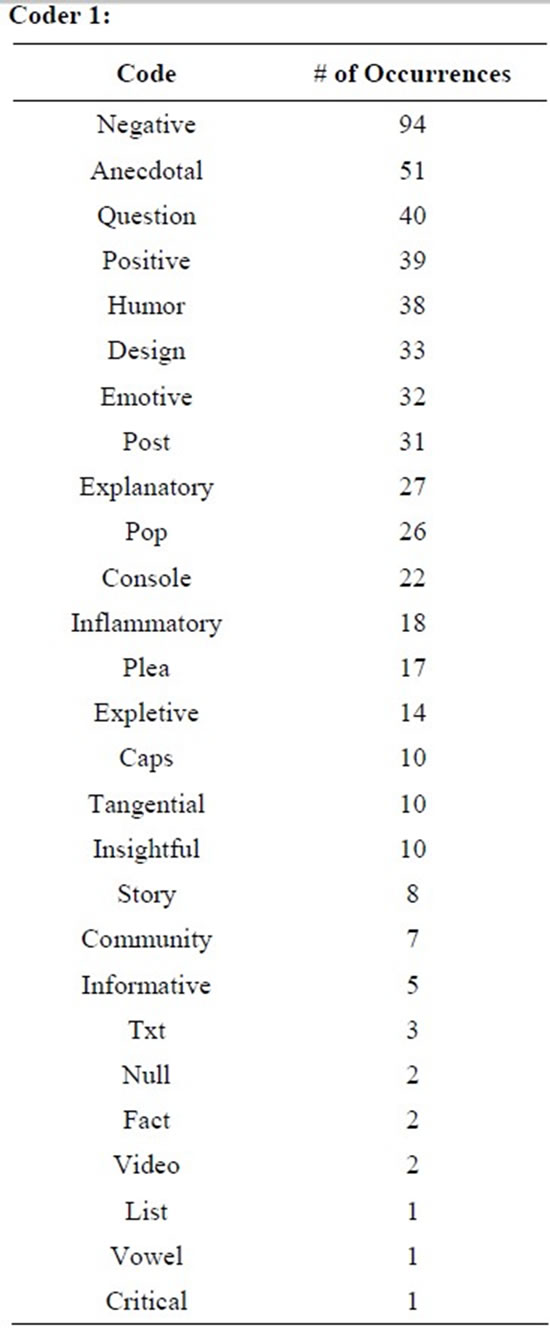
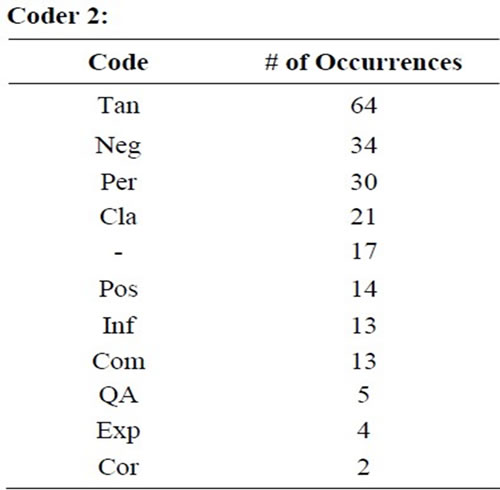
Table 3. Coder analysis.
ber of occurrences in both coding sets. This gave an indication that negative commenting on stories was important. Further investigation brings to light statistically significant relationships between negative comments and volume.


Figure 3. Mean thread percentage by negative comments, code set 1.
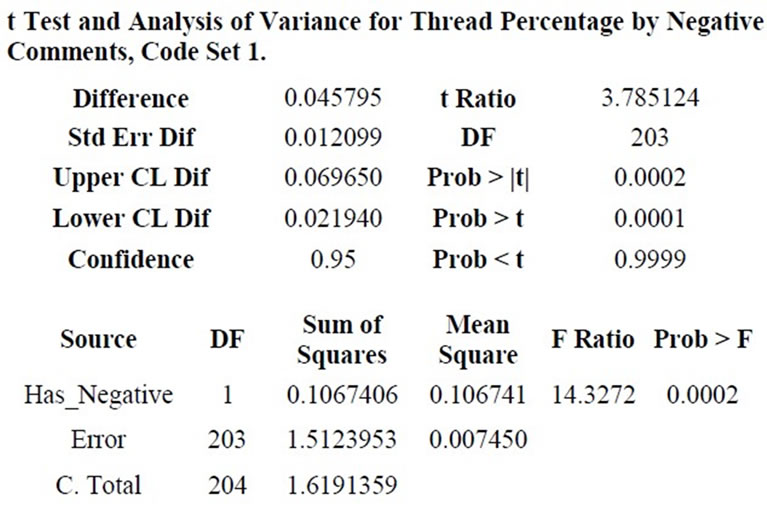

Figure 4. Mean thread percentage by negative comments, code set 2.
The above figures show an analysis of the variance of the code sets on negative comments. The bars indicate the mean thread percentage of the category. While the second set required the exclusion of one outlier, both sets show a significant relationship between the percentage of comments as replies to shout and if a comment was negative in nature. One scenario to explain this relationship is that a commenter responding negatively then causes an argument consuming much of the conversation on the topic. Alternatively, a large group of the readers replied to agree with the negative comment, eager to also make their stance known. In either case, this significant factor is one that will be further tested during the experimental phase of the study.
Related to negative comments, though not necessarily negative, were comments referring a preference for a particular video game console as seen in Figure 5. This code was only recognized by one of the coders, so data supporting this finding only came from one set.
Arguments for why this would be a significant guideline are similar to that of the negative code. Showing favoritism or distaste for a particular console is a way to cause an argument by those not sharing that opinion. This argument is so common that many who bring it up are


Figure 5. Number of front page responses by console comments, code set 1.
thought to be “trolls”, those looking to start an argument for personal satisfaction. While trolling may be viewed as a negative social action, its goals are similar to the goals of anyone trying to gain volume or attention in an online discussion. This combined with the difficultly of determining the commenter’s true intent, so no distinction was made between comments that may or may not have been trolling attempts.
4.2. Positive Comments
While there is an old saying, “You catch more flies with honey then you do with vinegar”, only one piece of evidence was found to support this popular phrase. While the first set of codes do not show a significant relationship between these two variables, the second set of qualitative codes does show this relationship. A correlation was found between positive comments and the number of replies the comments received. Since this is only present in one code set bias can be a factor in showing this relationship. Therefore testing positive comments was a primary goal within the second phase of the study.
As one can see in Figure 6, the positive front page comments received more replies, however in both code
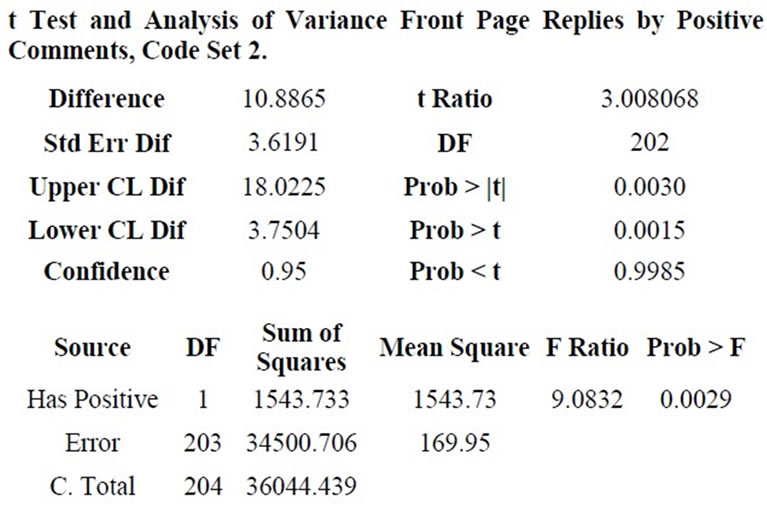

Figure 6. Front page replies by positive comments, code set 2.
sets there was no relationship between the positive comments and thread percentage, indicating that positive comments are not able to monopolize the conversation to the extent negative comments can.
4.3. Question Comments
The first set of qualitative codes only showed a single code that indicated a significantly lower chance of increasing volume, posting questions.
Figure 7 shows that shouts in the form of a question had a significantly lower number of replies that those which were not. This can be explained as the answer was quickly provided and the discussion did not continue as the answer was quickly accepted. This is not to say that questions did not have the same chance to become the shout in the thread, just that from these statistics they do so without a large number of replies, hence a lower volume. Further discussion of this finding and its implications on a question’s relationship with volume on a comment thread can be found in the conclusions chapter.
5. Discussion and Implication The discourse analysis discovered a number of possible memetic primers. These primers were then analyzed to
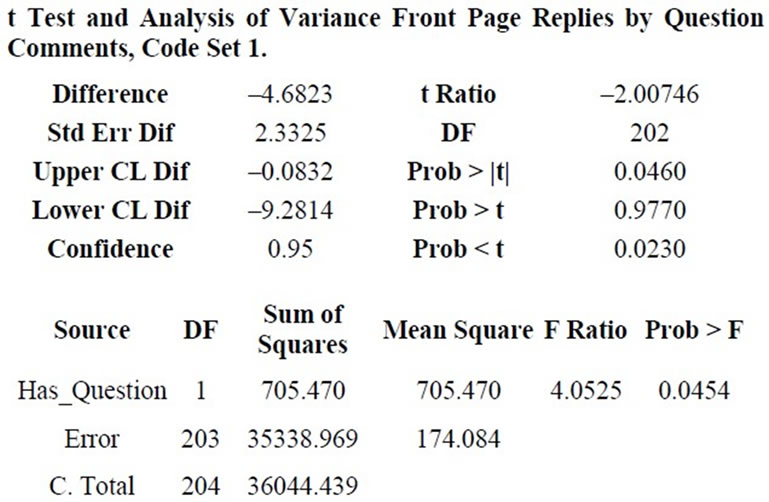
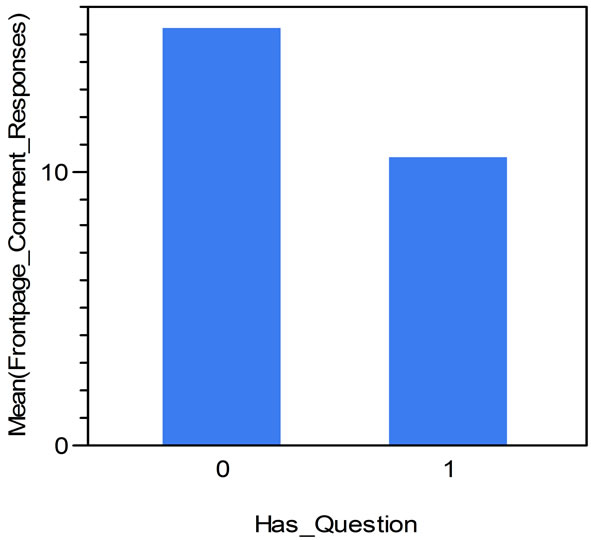
Figure 7. Front page replies by question comments, code set 1.
find any significant relationships between these memetic primers and measures of volume, thread percentage and number of replies. Negative comments showed a relationship with thread percentage in both coder sets. Positive and question comments showed significant relationship with number of replies in individual coder sets.
The use of blogs as trusted primary, sources of information has become a reality, and the people that comment on such blogs have the power to sway public policy through activism and discourse. The results found in this dissertation are important to understand the way these large communities can be influenced and possibly controlled. Information is abundant and at times overwhelming in the web, and we rely on our trusted online communities to help turn this data into knowledge. If there are disadvantages to trusting these online communities, they need to be exposed now so that these communities can continue to foster open discussion and interest into their various subjects. While the example of a gaming community is used within this study, I believe that the results can be generalized to other online interest groups.
Examples of online communities making an impact are numerous, bringing urgency to understanding them now. One example is that of the recent “Tea Party” groups in the United States calling for fiscal responsibility of the federal government. Regardless of the origins or motivations of this group, they have become a factor in the American political landscape. Online discussion helps build the social ties the Tea Party uses to grow [20,24,25]. Another example is the one mentioned in the literature review, of Reddit’s campaign to name the Greenpeace spokes-whale “Mr. Splashy Pants” [19]. While the community was nonsensical in its approach, the goals and impact they created is real. Understanding memetic primers will give individuals, corporations, and academia the perspectives they need to rationally analyze social movements.
The introduction of memetic primers as a concept is the primary contribution of this study. Understanding this aspect of online communication is important to the future of online communities as they continue to grow as major, and some cases, primary form of human to human engagement around the world. This chapter will explore the possible implications of memetic primers, what this study does to provide evidence for their existence and what actions might need to be taken in future studies of this form of communication and in the design of online communities.
Design Implications
This study has implications for the design of future blog sites. Blog geared to discussion may wish to implement comment systems that encourage differences in opinion and hide those which do not add new evidence to the discussion. Similar systems exist in a number of special interest blogs, such as Slashdot.org which focuses on science and computer news. A comparison of a blog with these systems and one without would also be an area of future work.
Sites such as Kotaku, Slashdot, Fark, and Reddit continue to change even during the course of writing this dissertation. As of the writing of this dissertation, Kotaku has incorporated Facebook logins for their commenting system, but has also kept the original, stand-alone, anonymous login system. This allows Kotaku community members to choose to have their comments seen by offline contacts or to be anonymous so that they can be as blunt and forthcoming as they please. A study on the use of memetic primers within a community dependent on a user’s known or anonymous status would shed some light into the social implications of particular memetic primers. While negative primers would be more effective at garnering attention to the author’s post, the possibility of the comment being seen in a poor light in the users’ local community could prevent their use.
As communities of special-topic blogs grow, these communities will also have to deal with their members aging and changing tastes, adjusting to new needs. This study focused on a gamer community, a demographic of people who played electronic games as children is now having its own children. As the community grows older, its stands to reason that the time available to allocate to online communities is shorter. This might make shouts and memes their primary connection to the community. Future work can be done to see how individuals remain active in blog communities as their contact with the communities shortens. It is possible that memetic primers will play an even more important role for these individuals seeking to quickly and easily keep up with the development of the community while dealing with day-to-day life.
REFERENCES
- L. A. Adamic and N. Glance, “The Political Blogosphere and the 2004 US Election: Divided They Blog,” Proceedings of the 3rd international Workshop on Link Discovery, Chicago, 21-24 August 2005.
- Y. Chi, B. L. Tseng and J. Tatemura, “Eigen-Trend: Trend Analysis in the Blogosphere Based on Singular Value Decompositions,” Proceedings of the 15th ACM International Conference on Information and Knowledge Management, Arlington, 5-10 November 2006.
- J. G. Conrad and F. Schilder, “Opinion Mining in Legal Blogs,” Proceedings of the 11th International Conference on Artificial Intelligence and Law, Stanford, 4-8 June 2007.
- PricewaterhouseCoopers, “How Consumer Conversation Will Transform Business,” Pricewaterhouse Coopers, London, 2008.
- I. Yucel, “Understanding the Sources and Bandwagon Effects in Blog Communities,” 2007. http://www.psu.edu/dept/medialab/researchpage/newabstracts/blog.html
- S. S. Sundar, A. Oeldorf-Hirsch and Q. Xu, “The Bandwagon Effect of Collaborative Filtering Technology,” CHI’08 Extended Abstracts on Human Factors in Computing Systems, Florence, 2008, pp. 3453-3458.
- S. S. Sundar, “The MAIN Model: A Heuristic Approach to Understanding Technology Effects on Credibility,” In: M. J. Metzger and A. J. Flanagin, Eds., Digital Media and Learning, 2007, pp. 73-100.
- R. McArthur, “Uncovering Deep User Context from Blogs,” Proceedings of the Second Workshop on Analytics for Noisy Unstructured Text Data, Singapore, 24 July 2008.
- P. Boutin, “Robot Wisdom on the Street,” 2005. http://www.wired.com/wired/archive/13.07/posts.html?pg=6
- R. Blood, “Weblogs: A History and Perspective,” 2000. http://www.rebeccablood.net/essays/weblog_history.html
- J. Bar-Ilan, “An Outsider’s View on ‘Topic-Oriented Blogging’,” Proceedings of the 13th International World Wide Web Conference on Alternate Track Papers & Posters, New York, 17-20 May 2004, pp. 28-34.
- B. Eatonweb, “The Blog Directory,” 2008. http://portal.eatonweb.com/
- R. Blood, “How Blogging Software Reshapes the Online Community,” Communications of ACM, Vol. 47, No. 12, 2004, pp. 53-55.
- K. R. Cohen, “A Welcome for Blogs. Continuum,” Journal of Media & Cultural Studies, Vol. 20, No. 2, 2006, pp. 161-173.
- M. Chymes, “An Incomplete Annotated History of Weblogs,” 2001. http://web.archive.org/web/20031119025356/
- http://www.chymes.org/hyper/weblogs.html
- S. J. Blackmore, “The Meme Machine,” Oxford University Press, New York, 1999.
- R. Dawkins, “The Selfish Gene,” Oxford University Press, Oxford, 1976.
- R. Brodie, “Virus of the Mind: The New Science of the Meme,” Integral Press, Seattle, 2004. www.youtube.com/watch?v=tPgQsv2KPwc
- A. Ohanian, “Alexis Ohanian: How to Make a Splash in Social Media,” 2009.
- B. Nyhan and J. Reifler, “When Corrections Fail: The Persistence of Political Misperceptions,” Political Behavior, Vol. 32, No. 2, 2010, pp. 303-330.
- S. S. Sundar and C. Nass, “Conceptualizing Sources in Online News,” Journal of Communication Research, Vol. 27, No. 6, 2001, pp. 683-703.
- N. Fairclough, “Critical Discourse Analysis and the Marketization of Public Discourse: The Universities,” Discourse & Society, Vol. 4, No. 2, 1993, pp. 133-168.
- J. P. Gee and J. L. Green, “Discourse Analysis, Learning, and Social Practice: A Methodological Study,” Review of Research in Education, Vol. 23, 1998, pp. 119-169.
- L. V. Braekel, “The Impact of Blogging on Society and Politics,” 2007. http://lvb.net/item/5470

